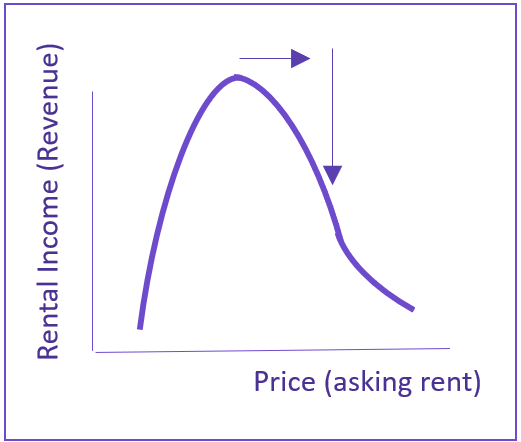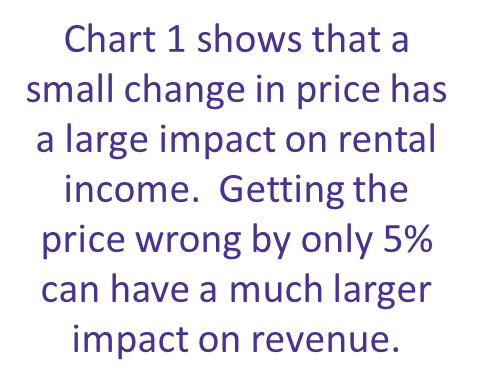If you charge too much, your empty units will remain empty. And what’s more, your existing tenants will vacate.
On the flip side… If you charge too little, your units will fill up quickly, and your existing tenants will stay. While the idea of a low vacancy rate sounds appealing, it also means you could have charged more and earned more revenue. Once your tenant has signed a lease at this low rate, you are locked into lower revenue until the lease ends. And in some jurisdictions, you will also be restricted in how quickly you can increase rents in the future.
Chart 1: Rental Income vs asking rent


So, how do you know if you are charging too much or too little, on average?
Unfortunately, there is no one simple metric.
Some operators track their vacancy rates. Their rule of thumb is “When the vacancy rate is high, I lower rents, and when the vacancy rate is low, I increase rents”. Ideally, these operators would want to see a vacancy rate which is:
- Stable over time
- Consistent across different attributes
- Within the range of the market vacancy rate
Keep in mind, the vacancy rate isn’t a good measure on its own:
- In the first 12-18 months of each community, the vacancy rate will be high. That doesn’t mean you should keep lowering your rents. In fact, the opposite applies! Our proprietary analysis shows that you should be gradually increasing your rents as your vacancy rate reduces.
- The vacancy rate moves slowly. If the market suddenly weakens, you want an early signal. However, the vacancy rate won’t give you that early signal because your existing tenants are locked into leases.
- Similarly, if you have no vacancies and the market suddenly strengthens further, the vacancy rate can’t reduce any further. Once again, you won’t get the signal you are looking for, so you won’t increase rents by enough when your next vacancy arises.
“…the vacancy rate isn’t a good measure on its own”
What’s more – Even if the vacancy rate was a was a perfect measure on which to base pricing, you still need sophisticated mathematics to calculate the optimal amount to increase/decrease rents when the vacancy rate changes.
Some operators track rents in the local area. For example, they might charge 20% more than the median 1 bedroom asking rent in their suburb. When the median rent goes up 5%, they increase their own rent by the same 5%.
This approach also has its challenges:
- Some suburbs don’t have a lot of vacant apartments, so the market data can be volatile. You could include surrounding suburbs to increase the sample size, however the surrounding suburbs might not be representative of your building.
- Similarly, the buildings in your suburb might differ from your own building. For example, they might be older, or they might cater to a different audience.
- Even if you have reliable and representative market data, you would still need sophisticated mathematics to identify whether the premium should be 5%, 10%, 15%, or some other number. This will vary from building to building, and suburb to suburb. And this optimal premium will change over time.
Some operators track the sales rate in their building. For example, they might aim for a sales rate of 4 units per month. This is the rate they believe they need to achieve, in order to replace tenants who don’t renew their leases.
Once again, this isn’t a perfect method:
- If you are targeting 4 sales per month, you might have a month with 2 sales, or 6 sales. This could be a reflection of pricing, or it could be random luck, just as 2 coin tosses won’t always result in 1 head and 1 tail. You might need 2 years of sales results to get a statistically significant result. However, the results from 2 years ago are no longer relevant, because the market rents and asking rents have moved in the meantime.
- Calculating the optimal number of sales per month isn’t as simple as it seems. Just because you had a particular number of new vacancies in the past year, that doesn’t mean you will have the same number next year. The number of new vacancies can be influenced by the duration of existing leases, when existing leases started, tenure of existing tenants, rent increases for each tenant, market rent increases, and penalties for breaking leases early.
Whether you are tracking vacancy rates, local median rents, sales rates, or any other metric, you need to get your mathematics right in order to forecast vacancies and new tenants, and to understand how sensitive they are to movements in rent.





